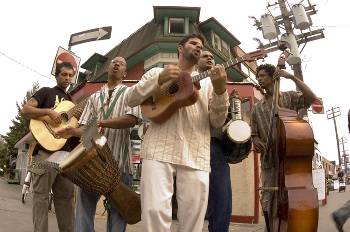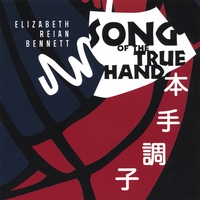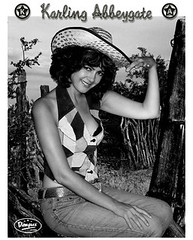Indie-cision [n]: a state of confusion over the question of what the heck is what in the music business
Category creep [n]: the process whereby a category expands to include more and more instances and eventually all instances, whereupon it ceases to be a category
Kenyata has mastered networking and the art of focus. Originally from a small Texas town and now based in Wilmington NC, he talks at a New York City clip – but about anything except his music, which he leaves to speak (and scream) for itself. That, whether he realizes it or not, makes him more interesting.
A cherub-faced Southern gentleman with piercing eyes, Kenyata turns into a monster of rock on stage. He and his band The Majestic Twelve played a full-throttle 30-minute set recently at Club Midway. Though he hadn’t appeared in New York City in a decade and was largely unknown to the local press and tastemakers, the room was filled with fans, hob-nobbers and well-wishers. Why?
Force of personality, for one thing. Kenyata’s, mostly. But creative public relations played a major part. The band’s publicist joined forces with a New York based trade publication and artist development company called Music Dish to promote a series of showcases for indie bands deemed worthwhile for no other reason than being interesting, and good.
But what does it mean to be indie?
The traditional distinction between indies and majors has, in fact, lost its meaning, according to Kenyata, who mentions by contrast some underground indie labels from the “good old days” that grew, more or less organically, out of a scene: Bomp, SST, Alternative Tentacles. Today things have changed: everyone wants “indie cred,” including labels that are distributed by or even owned by the majors. Matador, says Kenyata emphatically, is not an indie. That’s not technically true, but the point is that large, mainstream independent labels with big-selling artists have access to the same – or equivalent – brick-and-mortar distribution channels as the majors. Kenyata’s band, along with the vast majority of musical acts, does not.
I named my CD review column “Indie Round-Up” on purpose to give myself enough latitude to cover practically anything I was interested in. I’m not interested in writing about the music that’s coming out on the major labels today, even when I like it. What would be the point? It’s already everywhere. I dig Shakira, but you sure don’t need to hear me talk about her. Whereas you’d probably never heard of The Majestic Twelve – and now you have. And it’s a great band. So, chalk one up for me.
Kenyata prefers to talk about “independence” rather than “indie.” He means, not freedom from a major label, but artists being in control of their music and of the careers they try to build around it. The bands that developed under and comprised the indie labels of decades past worked, in many ways, harder than major label bands had to work. In the process they built scenes and communities.
Artists today need to learn from those predecessors. Kenyata talks of “constantly finding ways of doing things that other people haven’t thought of before, working to put us into a position where we can compete” with bands that have major distribution or label backing.
Case in point: the Majestic Twelve’s new video looks like an expensive major label production. But it isn’t – not even close. Kenyata tracked down the makers of an old Norwegian undersea film that had captivated him years earlier; bought worldwide rights to the footage for a tiny fraction of what the film had originally cost to make; and used it to construct the video for his new single.
Brilliant. Not because having a good video is the be-all and end-all, but because with something this good his band can stand out from the pack. The band’s videos are getting significant play on the Internet and have been licensed by Fuel TV.
Issuing a press release not about his music or video, not about the political messages in his lyrics, but about how the term “indie” has lost its meaning, was a pretty good idea too. Though not earthshaking, or even particularly original, it caught my attention.
So what, if not “indie,” should we call the vast majority of artists who don’t have major record deals?
DIY (“do it youself”) might do, except that it already refers to the bottom section of a three-part pyramid with “major” at the top and “indie” in the middle. That distinction dated from the heyday of indie rock, when DIY referred to artists who did everything completely on their own. But it was a weak distinction even then, since artists on indie labels always had to do a lot themselves, as noted above.
I don’t have an answer to this terminology question, but in the end, what artists are doing is more important than what they’re calling themselves, particularly now that the digital age has opened up so many avenues, which make things both more exciting and more frustrating. The possibilities seem endless now – but so does the competition. CD Baby, the top online CD store devoted to independents, alone carries the work of nearly 150,000 artists. Myspace, which plans to further commercialize its popularity by becoming a for-pay digital music download hub, claims three million band pages in its stable. And – argh – I’m one of them.
So, to get a fresh perspective and try to alleviate my “indie-cision,” I left New York in a rented Chevy Cobalt and headed to Nashville for the Americana Music Conference. But first I stopped in Raleigh to visit my cousin Z and hopefully meet some real Southern people.
Z, a New York transplant, has been boning up on country music – listening to the hits in her car, singing them on a home karaoke setup. At her Monday night poker game, I met some local neighbors. We played them my roots-country-rock CD and they dug it.
Real Southern people having dug my music, I went to sleep happy.
Chevying towards Tennessee the next day, I stopped for lunch in artsy Asheville NC. Like a miniature San Francisco, it’s full of artists and musicians trying to walk along the street without falling down the town’s steep mountain slope. The server at the pastry shop where I buy coffee noticed my Duke Gardens t-shirt – I’d visited the famous Gardens in Durham the previous day, while Z was at work – and told me she’s from “right near there.” I suspect that a great many of the people I saw in Asheville that beautiful afternoon were transplants from as far away as the touring bands who were booked to play the Orange Peel.
That evening, shaking from too much driving, I washed up at a gas station in Harriman TN to buy a map. Then I followed a sign that pointed down a hill to “live bluegrass music.” Only on weekends, I guess; that sleepy day it was just a riverside park with a .6 mile walking path around it, perfect for stretching out my shakes. Harriman’s good citizens, ambling Southern-slow around their park, looked at me funny as I strode by New-York-fast. I still had some adjusting to do.
I journeyed on to Nashville, where the Americana Music Association was putting on a Conference that showcased artists ranging from the gravelly Ray Wylie Hubbard to the bluegrass family Cherryholmes to the titanic prog-country of Darrell Scott to the angelic harmonies of the Anonymous 4. Luminaries Jim Lauderdale, Mindy Smith, Buddy Miller, James McMurtry, Marty Stuart, and Lee Rocker were present too, among many others.
Those with honored careers already behind them, like Hubbard and Lauderdale, seemed as happy to have a place to belong as did newer artists like Hayes Carll and Chris Knight. “Americana” as a classification or genre is quite new, having been boosted into existence on the strength of O Brother Where Art Thou, and it’s very inclusive. Any new music rooted in American folk forms counts as Americana, from raucous roots-rock to delicate mandolinitry.
And there’s another thing it all seems to have in common: it’s practically all indie.
Its awards ceremony may fill the world-famous Ryman Auditorium, honoring big names like Rosanne Cash, Rodney Crowell and Charlie Daniels; it may have its own radio programs and charts and its own yearly schmoozefest in downtown Music City. But the Americana scene is basically an indie one.
So, whether it’s a basement club in New York hosting art-punkers from North Carolina, or the Austin-based Americana scene descending on Nashville for three days in September, or three crabby middle-aged men with day jobs trying to think of creative ways to sell their music without touring (because of, um, those pesky day jobs) – it’s an indie world, and Shakira just lives in it.
There may be millions of Myspace bands out there, but it is possible, with some creative smarts, to go where no band has gone before.




